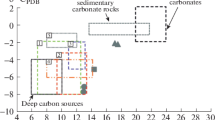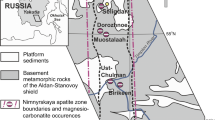Abstract
We present the results of a study on gabbroic rocks, syenites, pegmatites, carbonatites, and hydrothermal products of the Oshurkovo apatite-bearing massif. The results include Nd and Sr isotope ratios; the isotope compositions of carbon and oxygen in calcite; oxygen in apatite, magnetite, and silicate minerals (phlogopite, titanite, diopside, amphibole, K-feldspar, and quartz); sulfur in barite; and hydrogen in mica. The isotopic data are close to the EM-1 enriched mantle values and confirm a comagmatic relationship between the gabbros and carbonatites. The binary plot ɛNd vs. 87Sr/86Sr demonstrates strong differentiation between silicate rocks and carbonatites, as is the case with the other Late Mesozoic carbonatite occurrences of southwestern Transbaikalia. The oxygen isotope composition of all comagmatic phases also falls within the range of mantle values. A clear trend toward heavier oxygen and lighter carbon isotope compositions is observed in all successively emplaced phases, which is consistent with a trend defined by hydrothermal products formed under the influence of the parent magma chamber. Carbonates formed during the greenstone alteration of gabbroic rocks are enriched in the light oxygen isotope (δ18O from −2.8 to −7.3‰), suggesting a contribution of vadose water.
Similar content being viewed by others
References
A. N. Kuznetsov, Mineralogy and Geochemistry of Apatite-Bearing Diorites (Southwestern Transbaikalia) (Nauka. SO RAN, Novosibirsk, 1980) [in Russian].
B. A. Litvinovsky, V. V. Yarmolyuk, A. N. Zanvilevich, M. G. Shadaev, A. V. Nikiforov, and V. F. Posokhov, “Sources of material and genesis of granitic pegmatites of the Oshurkovskii alkaline monzonite massif, Transbaikalia,” Geochem. Int. 43(12), 1149–1167 (2005).
B. A. Litvinovsky, B. Jahn, A. N. Zanvilevich, and M. G. Shadaev, “Crustal fractionation in the petrogenesis of an alkali monzodiorite-syenite series: the Oshurkovo plutonic sheeted complex, Transbaikalia, Russia,” Lithos 64, 97–130 (2002).
A. V. Nikiforov, V. V. Yarmolyuk, and B. G. Pokrovskii, “Late Mesozoic carbonatites of Western Transbaikalia: mineralogical, chemical, and isotopic (O, C, S, and Sr) characteristics and relationships to alkaline magmatism,” Petrology 8(3), 278–301 (2000).
A. V. Nikiforov, V. V. Yarmolyuk, V. I. Kovalenko, V. G. Ivanov, and D. Z. Zhuravlev, “Late Mesozoic carbonatites of Western Transbaikalia: isotopic-geochemical characteristics and sources,” Petrology 10(2), 146–164 (2002).
A. N. Kuznetsov, “Sulfur isotope composition of pyrites from the Oshurkovo apatite-bearing diorite massif,” in Proceedings of 9th All-Union Symposium on Stable Isotopes in Geochemistry, Moscow, Russia, 1982 (Izd-vo AN SSSR, Moscow, 1982), pp. 461–465 [in Russian].
A. V. Ignat’ev and T. A. Velivetskaya, “Laser technique of sample preparation for stable isotope analysis,” in All-Russian Conference on Mass-Spectrometry and Its Applied Significance, Moscow, Russia, 2005 (Moscow, 2005) [in Russian].
V. M. Savatenkov, I. M. Morozova, and L. K. Levskii, “Behavior of the Sm-Nd, Rb-Sr, K-Ar, and U-Pb isotopic systems during alkaline metasomatism: fenites in the outer-contact zone of an ultramafic-alkaline intrusion,” Geochem. Int. 42(10), 899–920 (2004).
T. Chacko, D. R. Cole, and J. Horita, “Equilibrium oxygen, hydrogen and carbon isotope fractionation factor applicable to geological system,” in Stable Isotope Geochemistry, Rev. Mineral. Geochem. 43, 1–62 (2001).
Y.-F. Zheng, “On calculations of oxygen isotope fractionation in minerals,” Episodes 22(2), 99–106 (1999).
G. V. Andreev, I. V. Gordienko, A. N. Kuznetsov, and A. I. Kravchenko, Apatite-Bearing Diorites of the Southwestern Transbaikalia (Buryatskoe knizhnoe izd-vo, Ulan-Ude, 1972) [in Russian].
S. V. Kostromin and F. I. Koval’skii, Geological-Structural Features of the Oshurkovo Apatite Deposit and its Economic Significance (Buryatskoe knizhnoe izd-vo, Ulan-Ude, 1966) [in Russian].
A. N. Kostromina, Apatite Mineralization and Genesis of the Oshurkovo Deposit (Novosibirsk, 1971) [in Russian].
F. L. Smirnov, “Oshurkovo apatite deposit,” Sov. Geol., No. 4, 79–90 (1971).
G. V. Polyakov, V. I. Bognibov, A. P. Krivenko, and P. A. Balykin, “Origin, modes of occurrence, and distribution of Oshurkovo-type apatite mineralization in southern Siberia,” Geol. Geofiz., No. 6, 19–26 (1980).
L. G. Kuznetsova, V. B. Vasilenko, and L. D. Kholodova, “Compositional features of the rock-forming minerals of the Oshurkovo Massif,” in Materials on Genetic and Experimental Mineralogy (Novosibirsk, 1995), No. 832, pp. 81–97 [in Russian].
G. M. Yatsenko, “Oshurkovo-type intrusions in the central part of western Transbaikalia,” in Ore Potential of the Transbaikalian Geological Associations (Nauka, Novosibirsk, 1982), pp. 93–99 [in Russian].
Petrographic Code. Third Edition (Izd-vo VSEGEI, St. Petersburg, 2009) [in Russian].
M. G. Shadaev, V. F. Posokhov, and G. S. Ripp, “First data on Early Cretaceous pegmatites in Western Transbaikalia: Rb-Sr dating,” Russ. Geol. Geophys. 42(9), 1421–1424 (2001).
G. S. Ripp, O. V. Kobylkina, A. G. Doroshkevich, and A. O. Sharakshinov, Late Mesozoic Carbonatites of Western Transbaikalia (Izd-vo BNTs SO RAN, Ulan-Ude, 2000) [in Russian].
A. G. Doroshkevich and G. S. Ripp, “Isotopic systematics of the rocks of the Khalyuta carbonatite complex of Western Transbaikalia,” Geochem. Int. 47(12), 1198–1211 (2009).
N. V. Vladykin, “Sr and Nd isotope geochemistry of alkaline and carbonatite complexes of Siberia and Mongolia and some geodynamic consequences,” in Problems of Sources of Deep Magmatism and Plumes. Proceedings of 5th International Symposium, Petropavlovsk-Kamchatskii, Russia, 2005 (Irkutsk, 2005), pp. 15–30 [in Russian].
V. V. Vrublevskii and I. F. Gertner, “Nature of carbonatite-bearing complexes of folded areas: isotope evidence for mantle-crust interaction,” in Problems of Sources of Deep Magmatism and Plumes. Proceedings of 5th International Symposium, Petropavlovsk-Kamchatskii, Russia, 2005 (Irkutsk, 2005), pp. 30–49 [in Russian].
V. V. Yarmolyuk, V. G. Ivanov, and V. I. Kovalenko, “Sources of intraplate magmatism of Western Transbaikalia in the Late Mesozoic-Cenozoic: trace-element and isotope data,” Petrology 6(2), 115–138 (1998).
V. V. Yarmolyuk, A. V. Nikiforov, V. A. Kovalenko, V.G. Ivanov, and D. Z. Zhuravlev, “Sources of Late Mesozoic carbonatites of the Western Transbaikalia: trace-element and Sr-Nd isotope data,” Geokhimiya 39(1), 60–78 (2001).
I. V. Gordienko, V. S. Klimuk, V. G. Ivanov, and V. F. Posokhov, “New data on composition and age of bimodal volcanic series of the Tugnui riftogenic depression, Trans-Baikal Region,” Dokl. Earth Sci. 352(6), 273–276 (1997).
A. Zindler and S. R. Hart, “Chemical geodynamics,” Ann. Rev. Earth Planet. Sci. 14, 493–571 (1986).
P. F. O. Cordeiro, J. A. Brod, E. L. Dantas, and E. S. R. Bardosa, “Mineral chemistry, isotope geochemistry and petrogenesis of niobium-rich rocks from the Catalao I carbonatite-phoscorite complex, Central Brazil,” Lithos 118, 223–237 (2010).
I. Appora, J. M. Eiler, A. Matthews, and E. Stolper, “Experimental determination of oxygen isotope fractionations between CO2 vapor and soda-melilite melt,” Geochim. Cosmochim. Acta 67(3), 459–471 (2003).
J. Hoefs, Stable Isotope Geochemistry (Springer, 2009).
S. Epstein and H. P. Taylor, “Variation of O18/O16 in minerals and rocks,” in Researches in Geochemistry (Wiley, New York, 1967), Vol. 2, pp. 29–62.
H. P. Taylor, “The application of oxygen and hydrogen isotope studies to problems of hydrothermal alteration and ore deposition,” Econ. Geol. 69, 843–887 (1974).
T. Agemar, G. Worner, and A. Heumann, “Stable isotopes and amphibole chemistry on hydrothermally altered granitoids in the North Chilean Precordillera: a limited role of meteoric water?,” Contrib. Mineral. Petrol. 136, 331–344 (1999).
B. E. Taylor, J. C. Eichelberger, and H. R. Westrich, “Hydrogen isotopic evidence of rhyolitic magma degassing during shallow intrusion and eruption,” Nature 306, 541–545 (1983).
P. I. Nabelek, J. R. O’Neil, and J. J. Papike, “Vapor phase exsolution as the controlling factor in hydrogen isotope variation in granite rocks: the Notche Peak Granitic Stock, Utah,” Earth Planet Sci. Lett. 66, 137–150 (1983).
S. M. F. Sheppard, “Igneous rocks: III. Isotopic case studies of magmatism in Africa, Eurasia, and oceanic islands,” in Stable Isotopes, Rev. Mineral. 16, 319–368 (1986).
C. M. Graham, R. S. Harmon, and S. M. Sheppard, “Experimental hydrogen isotope studies: hydrogen isotope exchange between amphibole and water,” Am. Mineral. 69, 128–138 (1984).
T. W. Vennemann and J. R. O’Neil, “Hydrogen isotope exchange reactions between hydrous minerals and molecular hydrogen,” Geochim. Cosmochim. Acta 60, 2437–2451 (1996).
M. Marks, T. Vennemann, W. Siebet, and G. Markl, “Nd-, O-, and H-isotope evidence for complex, closed-system fluid evolution of the peralkaline Ilimaussaq Intrusion, South Greenland,” Geochim. Cosmochim. Acta 68(16), 3379–3395 (2004).
H. P. Taylor, J. Frechen, and E. T. Degens, “Oxygen and carbon isotope studies of carbonatites from the Laacher See District, West Germany and the Alno District, Sweden,” Geochim. Cosmochim. Acta 31, 407–430 (1967).
M. Javoy, F. Pineau, and H. Delorme, “Carbon and hydrogen isotopes in the mantle,” Chem. Geol. 57(1/2), 41–62 (1986).
P. Deines, “Stable Isotope Variation in Carbonatites,” in Carbonatites-Genesis and Evolution (Unwin Hyman, London, 1989), pp. 301–359.
A. Demeny, T. W. Vennemann, E. Hegner, G. Nady, J. A. Milton, Z. Embey-Isztin, Z. Homonnay, and G. Dobosi, “Trace element and C-O-Sr-Nd isotope evidence for subduction-related carbonate-silicate melts in marble xenoliths (Pannonian Basin, Hungary),” Lithos 75, 89–113 (2004).
J. Bottinga, “Calculation of fractionation factors for carbon and oxygen isotopic exchange in the system calcite-carbon dioxide-water,” J. Phys. Chem. 72(3), 800–808 (1968).
Author information
Authors and Affiliations
Corresponding author
Additional information
Original Russian Text © G.S. Ripp, A.G. Doroshkevich, E.I. Lastochkin, I.A. Izbrodin, 2014, published in Geokhimiya, 2014, Vol. 52, No. 4, pp. 302–318.
Rights and permissions
About this article
Cite this article
Ripp, G.S., Doroshkevich, A.G., Lastochkin, E.I. et al. Isotope and geochemical characteristics of rocks from the Oshurkovo apatite-bearing massif, Western Transbaikalia. Geochem. Int. 52, 271–286 (2014). https://doi.org/10.1134/S0016702914020074
Received:
Accepted:
Published:
Issue Date:
DOI: https://doi.org/10.1134/S0016702914020074




